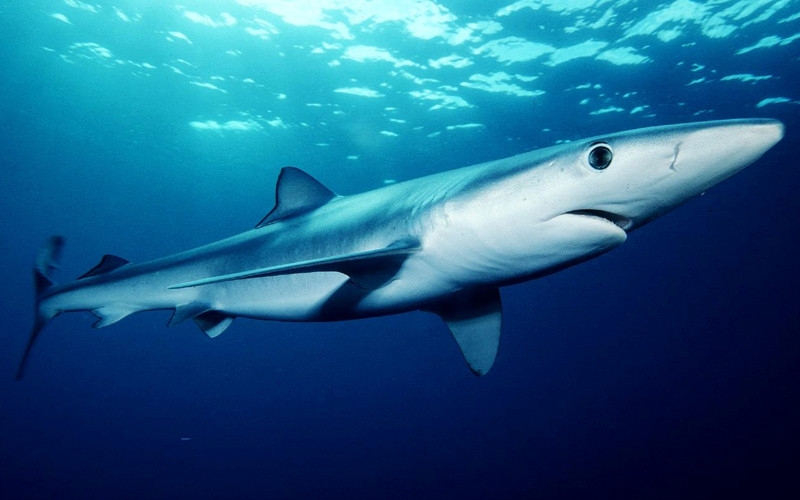Blue Shark – Prionace glauca
The “Prionace glauca” is a beautiful shark, with a blueish skin which gives it its common name. The term “glauca” comes from the Latin meaning “blue-gray” or “green.” It is the most distributed shark in the world.
It is a member of the order Carcharhiniformes, of the family Carcharhinidae and the Genus Prionace.
DESCRIPTION
The aerodynamic shape and lightness of the blue shark body allow it to move “elegantly” across the oceans. It exhibits countershading like many other sharks. The upper part is an indigo blue tone while the ventral and the sides are white.
It has a long caudal heterocercal fin. The second dorsal fin measures almost half the size of the first and its pectoral fins are unusually long compared to other sharks. Its eyes are large, its teeth are triangular, and it has a conical snout.
It reaches a length ranging from 3.8 to 4 meters and weighs about 240 kilograms. This species presents slight sexual dimorphism since the female tends to measure little more than 1 meter in comparison with the male.
It is the most distributed shark in the world.
DISTRIBUTION AND HABITAT
The blue shark inhabits in a great diversity of areas around the world. It dwells temperate, tropical and subtropical waters up to 350 meters deep. It lives near the coasts except those of Antarctica. It concentrates mainly in latitudes between 20 ° and 50 ° north and likes waters with temperatures of between 7 ° and 16 ° centigrade, although it can tolerate warmer temperatures slightly above 21 ° Celsius.
It fancies approaching the shores, where divers and boats see it often. It inhabits the epipelagic and mesopelagic zones near the coasts and the continental shelves, but if it dwells tropical waters, then it tends to go towards deeper waters.
FEEDING
It is a carnivorous predator that feeds on about 24 species of cephalopods and 16 species of fish. Its diet includes octopus, squid, mackerel, tunas, lobsters, crabs, small sharks and occasionally seabirds. They usually seek to catch small prey, but if they find large mammal carrion, it becomes part of their food.
The blue shark surrounds its prey before attacking it. When needed it joins with other sharks of the same species and cooperates to attack larger prey and facilitate their capture. Its swimming speed and its triangular teeth help this shark tearing the skin and flesh of the most complicated animals.
BEHAVIOR
It is a slow-swimming animal that increases its speed when feeling stimulated by external factors, such as the presence of animals from which it can feed on. If this happens, it then becomes one of the fastest fish.
The blue shark is nomadic and shows a clockwise migration pattern following the Gulf Stream to the Caribbean, passing along the coast of the United States, Eastern Europe, Southern Africa and back to the Caribbean.
REPRODUCTIVE HABITS
The Blue shark reaches sexual maturity at around 5 or 6 years old, after which can reproduce through viviparity. During the process of courtship, the male bites the female between the second and the first dorsal fin. Upon accepting, the male inserts its clasper into the female’s oviduct and transfers the sperm to fertilize the eggs. After mating both separate and do not join again, since this species is polygamous.
The frequency which females give birth or the time that the deposited sperm is stored after the intercourse is still uncertain, but the blue shark migrates northward to deliver their offspring. After a gestation period lasting between 9 and 12 months, the female gives birth to a large number of offspring. An unusual case was a mother that had 130 pups, but the average amount ranges between 25 and 50. Later, the newborns separate from their mother who does not provide any parental care.
The blue shark is not a regular victim of commercial fishing.
THREATS AND CONSERVATION
In contrast to other shark species, the blue shark is not a regular victim of commercial fishing although it is usually caught by fishing nets incidentally. Also, it is the target of sports activities in the United States, Australia and some parts of Europe.
As a consequence: the blue shark is “Near Threatened” according to the Red List of the International Union for the Conservation of Nature. Therefore, a group of organizations is committed to regulating fisheries and protecting the species, such as the International Plan of Action for the conservation and management of Sharks, the Sustainable Fisheries Act and the Code of Conduct for Responsible Fisheries from the Food and Agriculture Organization of the United Nations Fisheries and Aquaculture.
Some countries have banned shark finning, but still, there are not international treaties linking all aspects of blue shark protection.
Sources:
https://en.wikipedia.org/wiki/Blue_shark
http://www.iucnredlist.org/details/39381/0
http://www.arkive.org/blue-shark/prionace-glauca/
https://www.flmnh.ufl.edu/fish/discover/species-profiles/prionace-glauca
BioExpedition Publishing © 2017.

